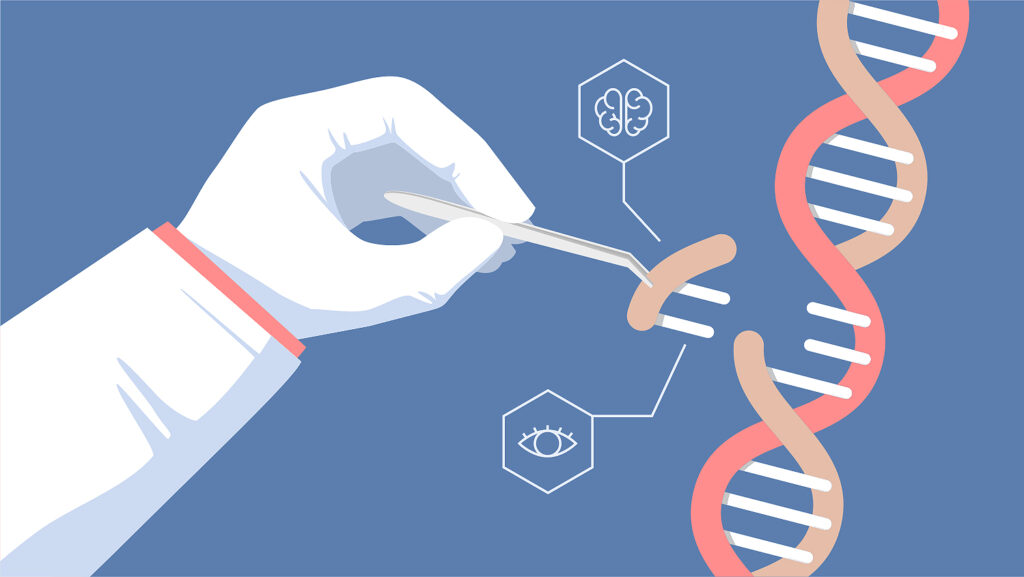
Genetic modification technology has experienced profound advancements since its inception, becoming a pivotal tool in modern science. Historically rooted in traditional breeding techniques, genetic modification began to take a definitive shape in the 1970s with the development of recombinant DNA technology. This breakthrough allowed scientists to cut and join DNA strands, facilitating the transfer of genetic material across different species. This capability marked the genesis of genetic engineering, a transformative phase that significantly expanded our understanding and manipulation of genetic material.
The fundamental scientific principle behind genetic modification is the alteration of an organism’s genome to achieve desired traits. This is accomplished by inserting, deleting, or modifying specific genes. Among the tools employed, CRISPR-Cas9 has emerged as a revolutionary technology. CRISPR, short for Clustered Regularly Interspaced Short Palindromic Repeats, along with the Cas9 protein, functions as a highly precise genome-editing mechanism, often compared to molecular scissors. CRISPR-Cas9’s ability to target specific DNA sequences with unparalleled accuracy has catalyzed its adoption in various fields, from agriculture to medicine.
Several milestone achievements underscore the rapid evolution and potential of genetic modification technology. The development of genetically modified crops, such as Bt cotton resistant to pests, has led to substantial increases in agricultural productivity and sustainability. In medicine, the production of insulin through genetically modified bacteria was a pioneering feat that revolutionized diabetes treatment. Recent advancements include the therapeutic use of CRISPR-Cas9 in correcting genetic disorders, exemplified by successful clinical trials targeting sickle cell anemia and muscular dystrophy.
The implications of these achievements are vast, heralding new possibilities for tackling global challenges such as food security, disease control, and environmental conservation. As we delve deeper into the frontier of genetic modification technology, a nuanced understanding of its historical context, scientific foundations, and potential impacts is essential for appreciating its role in shaping the future of science and technology.
The Benefits of Genetic Modification
Genetic modification technology has ushered in an era of unprecedented advancements across various sectors. One of the most notable applications is in agriculture, where genetically modified (GM) crops have become a game-changer. These crops are engineered to be more resistant to pests, diseases, and environmental stresses such as drought and extreme temperatures. For instance, Bt cotton, a GM crop, has been specifically designed to resist insect pests, resulting in reduced reliance on chemical pesticides and increased yield. This not only enhances food security but also promotes sustainable farming practices by reducing environmental pollution.
In the medical field, genetic modification offers groundbreaking potential through gene therapy. This innovative approach involves altering the genes within an individual’s cells to treat or prevent diseases. Gene therapy holds promise for treating a myriad of genetic disorders, such as cystic fibrosis, hemophilia, and muscular dystrophy. Additionally, the advent of personalized medicine, bolstered by genetic modification, enables treatments tailored to an individual’s genetic makeup. This personalized approach optimizes therapeutic efficacy and minimizes adverse effects, exemplifying the profound impact of genetic modification on healthcare.
Environmental applications of genetic modification are equally transformative. Bioremediation, the use of organisms to detoxify polluted environments, is being revolutionized by genetic engineering. Scientists have developed genetically modified bacteria capable of breaking down oil spills and degrading plastic waste, offering a viable solution to pressing environmental challenges. For example, a strain of Pseudomonas putida has been engineered to degrade toluene, a toxic component of industrial waste. This biotechnological innovation underscores the environmental benefits of genetic modification, providing sustainable means to restore ecological balance.
Real-world examples further highlight the tangible benefits of genetic modification. The Golden Rice project, which developed rice enriched with Vitamin A, aims to alleviate nutrient deficiencies in populations highly dependent on rice staples. In medicine, the successful treatment of severe combined immunodeficiency (SCID) using gene therapy exemplifies the lifesaving potential of genetic modification. These examples illustrate the broad spectrum of advantages, reinforcing the pivotal role of genetic modification in advancing agriculture, healthcare, and environmental sustainability.
The Risks and Ethical Concerns
While genetic modification technology offers groundbreaking possibilities, it is not without significant risks and ethical concerns. One major issue is the potential for unintended consequences on ecosystems. Genetically modified organisms (GMOs) have the capacity to disrupt natural species and biodiversity. For instance, the introduction of a genetically engineered organism into the wild could lead to unforeseen effects, such as the displacement of local species or the creation of new, invasive species. These disruptions can cascade through ecosystems, leading to ecological imbalances that are difficult, if not impossible, to reverse.
Ethical dilemmas also abound, particularly in the realm of human gene editing. The concept of ‘designer babies’—where genetic modification could be used to select for desired traits—raises many ethical questions. Critics argue that this could lead to a new form of genetic discrimination, where individuals with certain genes are privileged over those without. There is also concern about the equitable access to such technologies; without proper regulation, only wealthy individuals might afford these modifications, potentially exacerbating social inequalities.
Regulatory challenges present another significant hurdle. The rapid pace of genetic modification advancements has outstripped the development of comprehensive regulatory frameworks. This regulatory lag leaves a gap where unregulated or poorly regulated genetic modifications could pose risks to both human health and the environment. Stringent biosafety measures are essential to mitigate these risks and ensure that genetic modifications are introduced in a controlled manner.
Various stakeholders contribute diverse perspectives to this complex issue. Scientists highlight the need for meticulous research to understand long-term impacts, while ethicists emphasize the moral implications of altering the genetic fabric of life. Policymakers play a crucial role in crafting regulations that balance innovation with public safety. Thus, a multi-faceted approach, incorporating input from all these stakeholders, is essential for responsibly navigating the frontier of genetic modification technology.
Future Perspectives and Conclusion
As we look toward the future of genetic modification technology, several promising areas of research and innovation stand out. Advancements in CRISPR-Cas9 and other gene-editing techniques are making it increasingly feasible to precisely and efficiently alter genetic material. These improvements could lead to groundbreaking developments in fields such as agriculture, where genetically modified crops could be engineered to be more resistant to pests and diseases, significantly improving food security. Moreover, ongoing research into gene drives holds the potential to eliminate vector-borne diseases by altering the genomes of populations of organisms such as mosquitoes.
Another exciting frontier is within the realm of healthcare. Gene therapy has shown considerable promise in treating genetic disorders that were once deemed incurable. Diseases like cystic fibrosis, muscular dystrophy, and certain types of cancer could become manageable, if not entirely eradicated, through sophisticated genetic engineering techniques. Efforts to reduce the risk of off-target effects and improve the safety and efficacy of these therapies are crucial and are currently the focus of intense research.
The ethical and regulatory landscapes surrounding genetic modification are also likely to evolve significantly. As these technologies advance, there will be an increasing need for robust regulations that can adapt quickly to new scientific discoveries. Regulatory bodies will need to ensure that ethical considerations keep pace with technological capabilities, especially as humanity navigates the complex questions around human genetic enhancement, biodiversity, and ecological impacts. Public discourse and consensus will play pivotal roles in shaping these frameworks.
In the long term, genetic modification technology could be transformative in addressing global challenges. From combating the effects of climate change by engineering crops that can withstand extreme weather conditions to enhancing healthcare and eradicating diseases, the potential benefits are immense. However, it is vital to approach these advancements with caution, ensuring that risks are adequately managed and ethical considerations are at the forefront of continued development.
Overall, while genetic modification presents some significant challenges and ethical questions, the potential benefits for humanity are substantial. Embracing this technology, when done responsibly, could lead to revolutionary changes in how we address some of the world’s most pressing issues. Ongoing research and evolving regulatory frameworks will be key in harnessing the full potential of genetic modification technology.







